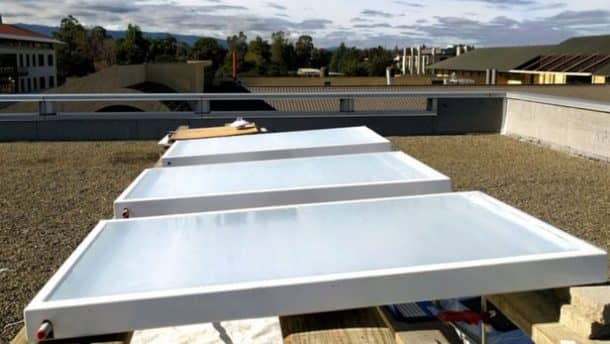Human species have been dealing with the problem of extreme temperature for millions of years. Why can’t this entire world maintain a 25 degree Celsius temperature that we all love? Well, many systems have evolved to control the temperatures for us like heaters and air conditioners. They work quite well except they consume so much energy that make them quite expensive.
A team from Stanford has been trying for years to come up with a cost effective solution that can be mounted on the roof to keep the building cool simply by radiating the excess heat into space. The only problem is that heat flows from hot things to cold things, and the outsides are clearly hotter than the insides. The solar panel-like device created by the Stanford team can cool water without using any source of external energy.
The Stanford system has been labeled ‘Radiative Sky Cooling’ by its developers and it made its first appearance in 2013. The cooling system extracts thermal radiation from the building and emits it out at such a wavelength that it escapes ito the outer space without warming our atmosphere. The cooling panel is coated with a multilayer optical film that reflects 97 percent of the sunlight directed onto it, so your house will stay cool even on the hottest of summer days.

The study was published in the journal Nature Energy and Shanhui Fan, the senior author of the study, explained,
“If you have something that is very cold – like space – and you can dissipate heat into it, then you can do cooling without any electricity or work. The heat just flows. For this reason, the amount of heat flow off the Earth that goes to the universe is enormous.”
The initial tests of the system were conducted using 8 inches (20cm) wide wafers to keep the surface of the material cool. Later, the same was used as a coating for solar panels for maximum efficiency.
The team has now managed to scale up the cooling system to a level where the wafers can easily cool down the running water that may run through a building to cool it down. They placed four of these reflective panels measuring 2 square feet on a rooftop where the water was flowing in the pipes underneath. In the next three days, the panels reduced the temperature of water upto 3° to 5° C than the surrounding air.

The results obtained from these tests were used to simulate how the panels would function in a double story building amidst the hot and arid climate of Las Vegas. A vapor compression system was used to cool down the building where the condenser itself was cooled by the panels. The reflective material brought down the energy needs of the system by 20 percent, thus saving 14.3 MWh of electricity. The energy savings went from 18 percent to 50 percent depending on the daily temperature conditions and atmosphere.
Aaswath Rama, the co-lead author of the study, added,
“This research builds on our previous work with radiative sky cooling but takes it to the next level. It provides for the first time a high-fidelity technology demonstration of how you can use radiative sky cooling to passively cool a fluid and, in doing so, connect it with cooling systems to save electricity.”
The cooling system will be developed further by SkyCool Systems, the company founded by the Stanford team. Currently, they are working on integrating these panels into air conditioning and refrigeration systems. The team then looks forward to cool down the gigantic data centers.
It is rightly said that every problem comes with the solution, we just need to figure it out!


